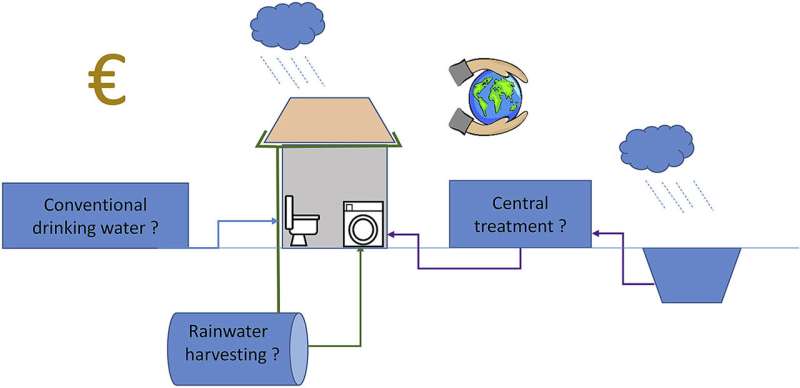Is it sensible to use rainwater to flush the toilet?

As a world first, a new residential district in Aarhus is using secondary water from the local water utility for toilets and washing machines. The solution is supported by a life cycle assessment.
The new residential district NYE in Aarhus has been built with an eye for sustainability at every corner. Therefore, it was also part of the developer’s plan to build a dual water system, with one system for drinking water and another for secondary water. Secondary water is runoff water from surfaces and drains which is collected, cleaned and used for non-potable applications such as toilet flushing and washing machines.
Aarhus Vand, which is responsible for supplying water to area, however, wanted to clarify whether saving such a scarce environmental resource as groundwater might have unfortunate consequences as regards other environmental aspects.
The utility therefore contacted DTU Environment. Here, Maria Faragò initiated a life cycle assessment supplemented with an economic impact assessment—a so-called eco-efficiency analysis—in order to create an overview.
Analysis points to several sensible factors
In the new residential district, all rainwater and surface water is collected in a number of basins, which also act as climate protection in connection with storm water management. In addition, water is collected from drainage pipes on the buildings and along the roads. The two types of water are treated at separate water treatment plants. As there are no standards yet for this type of secondary water, and as using it in washing machines requires the water to be free of any allergenic substances, it is purified to a quality which is almost on a par to that of drinking water.
“Based on the data that was available from Aarhus Vand, I carried out an analysis that includes a wide range of parameters which are significant for the environment. There is no clear-cut result, but in three key areas there is no doubt that the solution with secondary water makes sense from the point of view of sustainability,” says Maria Faragò.
“First, the solution means that less groundwater is used. In addition, rainwater is much softer than groundwater. This means that consumers save electricity and detergent etc. by not having to descale their washing machines as often,” says Maria Faragò.
Investment in a different type of tank
Finally, the economic assessment showed that it was much cheaper and more sustainable to use a plastic tank to store the treated secondary water at the water treatment plant rather than to invest in a stainless steel tank, which is most frequently used. This is largely due to the fact that plastic is significantly lighter than steel, and as steel is very resource-intensive to both manufacture and transport, plastic is the best choice.
“The study was very valuable for us. We would have been reluctant to install a dual water system in the new district if the analysis had shown that it did not make sense in terms of sustainability. In particular, because it is only the first stage of the new district, which will be expanded further in the coming years. Here, our experience with the secondary water supply system in the first phase will definitely be used for reference purposes,” says Kristian Brunmark, project manager at Aarhus Vand.
Other municipalities have shown an interest in the solution with the dual water system at NYE. As Kristian Brunmark says, however, the solution is only viable in connection with new-build projects, as it would be too expensive to install an extra set of pipes for secondary water in existing buildings.
Once the system has been in operation for a year, DTU and Aarhus Vand hope to be able to update the analysis with actual figures from the operating period.
Maria Faragò et al, An eco-efficiency evaluation of community-scale rainwater and stormwater harvesting in Aarhus, Denmark, Journal of Cleaner Production (2019). DOI: 10.1016/j.jclepro.2019.01.265
Citation:
Is it sensible to use rainwater to flush the toilet? (2021, November 18)
retrieved 18 November 2021
from https://techxplore.com/news/2021-11-rainwater-flush-toilet.html
This document is subject to copyright. Apart from any fair dealing for the purpose of private study or research, no
part may be reproduced without the written permission. The content is provided for information purposes only.
For all the latest Technology News Click Here
For the latest news and updates, follow us on Google News.

